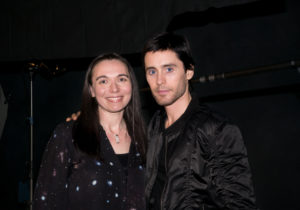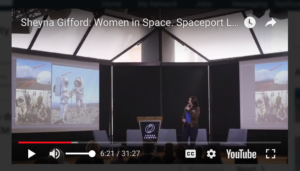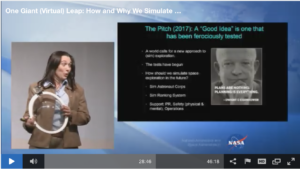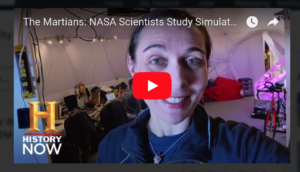In response to requests, here is a list of all of the stories I have written over the years about space and space-related science! With a few assorted podcasts, videos, and live science shows thrown in for good measure…
-
Nerdette’s finest! Life on Mars with Dr. Sheyna Gifford
- Beyond the Horizon – Close Encounters with The Future of Humanity in Space and Jared Leto
-
SPACE NEEDS YOU – TedX
-
Next Breakthrough in Exoplanet Discovery
- Noting how, “The search for life in the Universe has been transformed from speculation to a data-driven science,” speakers like Stanford physicist Peter Michelson offered detailed plans for finding life on exoplanets. Over the course of two days on April 20-21, dozens of scientists attending the Breakthrough Discuss Conference contemplated options for exploring planets in other star systems. These option included using a new generation of powerful telescopes for long distance observations, as well as advancing a first-of-its-kind technology to visit other star systems — all within the next generation.
-
All that Life Needs On Enceladus
- If chemical energy is life’s coin and water is life’s marketplace, there may be a swift economy alive and well beneath the icy shell of Saturn’s brightest moon. Such was the announcement during NASA’s April 13th press conference: that all three of the presumed key ingredients for life have been detected coming from Enceladus.
- Visions of the Future: Planetary Exploration through 2050
-
How old Is Life on Earth?
-
How old is life on Earth, and how do we know?
The answer of course, is fossils. But what kind of fossil records do early life-forms – single-celled organisms with no shells or bones – leave behind?If you were standing on TRAPPIST-1D looking out at the other six planets in your system, they would look large – something like our moon does to us – but be moving much faster. For all seven of the planets circling around TRAPPIST-1, revealed by NASA as the largest catch of Earth-like planets ever discovered, are packed tightly around their ultra-cool dwarf star, giving us a tantalizing opportunity to peer directly into the atmospheres of possibly habitable worlds. The answer may be: rust.
Researchers from NASA and the University of London announced that they discovered what may be the world’s oldest fossil to date: rust-colored tube-like structures similar to those created by single-celled organisms living near today’s deep-ocean vents. These newly-discovered ancient fossilized tubes are tiny – half the width of a human hair – and are hence called microfossils. The microfossils’ rusty color comes from the iron that these microscopic creatures used as an energy source when they lived near the ocean floor at least 3.77-billion years ago.
-
- Women in Space – LA Spaceport
-
Welcome to Trappist-1
- If you were standing on TRAPPIST-1D looking out at the other six planets in your system, they would look large – something like our moon does to us – but be moving much faster. For all seven of the planets circling around TRAPPIST-1, revealed by NASA as the largest catch of Earth-like planets ever discovered, are packed tightly around their ultra-cool dwarf star, giving us a tantalizing opportunity to peer directly into the atmospheres of possibly habitable worlds.
-
Destination Europa
- Planetary science as we know it today is motivated by questions about how life on Earth began, whether or not it has evolved in other parts of the solar system, and, most of all, if we are alone.
NASA has a new plan to help answer those questions. The three-part search for life would enhance the Europa Multiple Flyby Mission (EMFM), set to commence in the 2020’s. Launched separately from the EMFM and carrying at least 8 instruments, the lander could look for biosignatures – chemical or biological evidence of life – assess habitability of the surface environment, and send back information to vital to subsequent robotic missions.
- Planetary science as we know it today is motivated by questions about how life on Earth began, whether or not it has evolved in other parts of the solar system, and, most of all, if we are alone.
-
The Future of Space Simulation: Live at Johnson Space Center
- The Presentation starts 14 minutes into the recording
- Citizen Science! StarTalk Live at Sketchfest
- StarTalk Live! returns to take over SF Sketchfest for the fourth year in a row! Recorded earlier this year, StarTalk All-Stars host Bill Nye was joined by comic co-host Eugene Mirman, space activist and citizen scientist Ariel Waldman, SF Sketchfest co-founder Janet Varney, and comedian Claudia O’Doherty to talk about space innovations, “hacking” space exploration, and the future of human space travel. Ariel sits on the council for NASA Innovative Advanced Concepts, which develops radical science-fiction based ideas that could advance the frontier of space travel.
- The Ocean Beneath Pluto’s Wandering Heart
- The best current evidence that we have for Pluto’s possible ocean comes from Pluto’s wandering heart: a large geologic feature that looks a bit like Earth’s first artificial satellite, Sputnik. Sputnik Planum, as it’s come to be called, seems to have been made when a large object struck Pluto near its north pole. A paper published on November 16th, 2016 points out that the crater should have remained a heart-shaped hole in the ground, with less mass than when it started. Instead, Sputnik Planum grew and grew, so much so that it actually caused Pluto’s access to tilt. Models of how this might be possible call for a substantial amount of water under a crust of frozen nitrogen.
- Welcome to Mars, TGO!
- On October 19, the European Space Agency (ESA) and Roscosmos, the Russian Space Agency, celebrated as their joint satellite ExoMars with its Trace Gas Explorer (TGO) slid into orbit around the red planet. This is only the second time that ESA has successfully put a satellite into orbit around Mars. The last time was 2003, when Mars Express arrived to study the atmosphere and look for water. For the last 13 years, Mars Express has sent back brilliant pictures of how water has changed the surface of our neighboring world and captured the scintillating ultraviolet auroras that shine over the north and south poles. TGO’s mission builds on that search for life by detecting another compound linked with life: methane.
- Rosetta’s Comet
- Thanks to Rosetta, we know for sure that chemicals living in our own DNA, proteins, and cell membranes can be found in the furthest corners of the Solar System. More such discoveries likely lie in store as researchers troll through two years of streaming data — a stream that finally came to an end on September 30th, 2016, as Rosetta dove into comet C-G, reporting on everything it saw, touched, and smelled with its many sensors, right up to when it finally came to rest on the face of that dark, slightly-less-mysterious-than-before, wandering body.
- Plumes and The Search for Life on Europa
- Plumes – great jets of subsurface water forced through the moon’s thick ice sheet – were first spotted spraying out of Europa’s southern pole in December 2012. At least, that’s what the scientific community hoped was going on when Hubble first captured images of something bright in the ultraviolet spectrum “shooting” out of an area known to have fissures, or cracks that arise as Europa is deformed by Jupiter’s gravity. In the hopes of finding more evidence that this image was, indeed, a plume, not some other phenomenon, a separate team of scientists started watching Europa as it passed between Earth and Jupiter. The idea was this: if a liquid is being squeezed out of a solid body into space, it should spray cross Jupiter’s face, leaving a shadow.
- History Channel: The Martians
- Answers for Earthlings: Medicine In Space
Scary but true, there are stories that I wrote for actual newspapers and magazines that are only in print. If I can, I will find them and archive them. Copyright secured by Digiprove © 2018
Copyright secured by Digiprove © 2018







